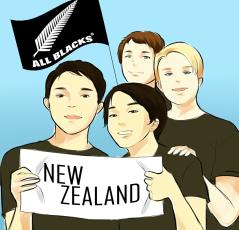Introduction: Connections between Asia and Aotearoa New Zealand
There have always been Asian people living in New Zealand: for example, Chinese have been in Aotearoa since the 1800's. Sadly, however, their treatment in the early years, post-Pākehā (Caucasian) arrival in New Zealand, was abysmal, as witness the especially racist Chinese Immigrants Tax of 1881, which was only repealed in 1944; while there were also several other very restrictive government actions pertaining to Chinese immigration throughout the twentieth century. Indians, also, had to contend with Undesirable Hawkers Prevention Bill 1896. All such pernicious ethnicity-based measures strongly paralleled the strictures put into place to ensure discrimination against Māori – again, lasting well into the 1950s and beyond.
However, I also want to state that the population of Aotearoa-New Zealand is increasing exponentially; with more and more people of Asian extraction — whether they initially come from Philippines, 'Mainland' PR China, Thailand, Cambodia, India or elsewhere — coming to the country to live as permanent residents and citizens. At the same time the birth rates of Asian people already here, remains higher than that of the Pākehā segment of the nation's population and the resident Asian populace will exceed Māori by 2026. Indeed, Hindi is the fourth most spoken language here now. Relatedly, there are also more Kiwis who can claim Asian parentage, as Asian folk intermarry with Pākehā.
More than this, in this age of globalised travel and interplay between this nation’s economy and those of Asian nations, more Pākehā not only travel throughout Asia, but also live and work there for long periods of time and – in several cases - marry local citizens, just as many Kiwi Asians go back and forth to the homes of their ancestors.
I am intrinsically so involved, because my whānau (family) is Asian. My wife is from Philippines, my step-children born and raised in Hong Kong, with a Chinese father. We carry passports from three separate nations. The main languages in our household are Cantonese, Tagalog, Māori and English, while my wife's own first language is Kapampangan and my children speak Putonghua (Mandarin) fluently while I speak and write Bahasa Melayu (Malay) because of several years residing in Brunei Darussalam. I have also spent over 10 of the last 15 years in Hong Kong, so that my own recent collection of poems, Atonement, was jointly published there and Macao, with a separate publication in Philippines. Pauline Wu is the artist who designed and drew the picture heading this introduction: she is my daughter, who has also designed the covers and internal artwork of several of my other books.
Plus, of course, resident Pākehā poets now also write about Asian influences in Aotearoa New Zealand. All of which is excellent.
What does all this mean for poetry in Aotearoa? Obviously there are more and more Kiwi Asian poets, such as Alison Wong; Kiri Piahana-Wong; Chris Tse; Gregory Kan; Ivy Alvarez; Dr Stephen Chan; Madeleine Marie Slavick; Nina Powles; Ya-wen Ho, Renee Liang, among several others. [Please see my Jacket 2 commentary at http.jacket2.org for more detailed comments regarding Kiwi-Asian poets.]
Therefore, from all the points made earlier, there is more and more poetry written about Asia per se. So there is already a thriving poetic that is - is some vital ways - Asian textured, Asian-influenced, exponentially evolving and growing well away from the poets and poetry represented in mainstream Aotearoa writing. These Asian and Asian-influenced poets won't always/ever be writing in English, which is also excellent — why should they? More, they won't necessarily be writing about well-worn Pākehā themes and tropes either.
Currently, perhaps, such poets of whatever ethnicity are more on the edge, the periphery, the margins of the Aotearoa New Zealand poetic, but as I am intimating strongly, the ‘mainstream’ fabric is rather swiftly eroding away into a far more multicultural texture across this country.
All hail to the poets represented in this Blackmail Press issue – whether they be in New Zealand or beyond. Regardless of ethnicity, they convey in their own separate ways, Asia intertwining Aotearoa in 2017.
Vaughan Rapatahana
Morenawhira, Aotearoa New Zealand; Tin Shui Wai, Hong Kong SAR; Pampanga, Phiippines.
September, 2017.

